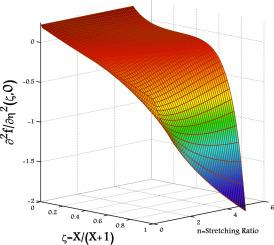European Journal of Mechanics - B/Fluids ( IF 2.5 ) Pub Date : 2020-11-21 , DOI: 10.1016/j.euromechflu.2020.11.006 Amin Jafarimoghaddam , Mustafa Turkyilmazoglu , A.V. Roşca , I. Pop

|
In the present research, it is solved in an innovative manner the essentially Non-Similar nanofluids jet discharged over a generalized non-linearly stretching wall. The Non-Similar set-up is interpreted as a combination of wall jet flow at the leading edge and non-linearly stretching sheet flow far away from it. Nanofluids are simulated employing Buongiorno’s two-phase model together with a modified boundary condition for nanoparticles transport equation. The compositely-transformed partial differential equations (PDE) of Non-Similar forms were solved numerically after employing a new mapping function to abridge the horizontal coordinate of an infinite length into a finite one. The numerical algorithm contains quasi-linearization technique together with an implicit algorithm of tridiagonal form. It should be pointed out that such a new Non-Similar setup is brought into account for the first time in the literature. In this respect, we summarize the outstanding novel findings of the present work as:
- •
[I.] Accounting a modified boundary condition for nanoparticles concentration at the wall, the so-called and widely-used Brownian motion parameter, namely , will have absolutely NO impact on Nusselt number or more precisely, on Energy Equation. In this respect, it is presented a new way of defining dimensionless variables.
- •
[II.] As the stretching ratio increases, it is observed a discrepancy in boundary layer thickness; it expands close to the jet area, shrinks in the transition region and adapts the far-field condition, either by expanding or shrinking, depending on the stretching ratio.
- •
[III.] As the stretching ratio increases, Nusselt number decreases slightly shortly after the jet origin and then increases dramatically to match the stretching region.
- •
[IV.] As the stretching ratio increases, nanoparticles at the wall become more concentrated at the downstream and hence, close to the jet region as well as the transition region, the concentration is sparse.
- •
[V.] As thermophoresis parameter, namely , increases, convective heat transfer coefficient drops non-uniformly, from the leading edge to downstream, as well as nanoparticles concentration at the wall.
- •
[V1.] As Schmidt number increases, convective heat transfer drops; however, nanoparticles concentration at the wall increases over the entire spatial domain.
中文翻译:

弹性壁射流的完整理论:具有两相纳米流体的新流动几何
在本研究中,它以创新的方式解决了在广义非线性拉伸壁上喷射的基本非相似纳米流体的喷射问题。“非相似”设置解释为前缘处的壁面射流和远离其的非线性拉伸板料流的组合。使用Buongiorno的两相模型以及修饰的边界条件对纳米流体的传输方程进行了模拟。在使用新的映射函数将无限长的水平坐标简化为有限的一个之后,对非相似形式的复合变换偏微分方程(PDE)进行了数值求解。数值算法包含准线性化技术以及隐含的三对角形式算法。应该指出的是,这种新的非相似设置在文献中首次被考虑在内。在这方面,我们将本工作的杰出新颖发现总结为:
- •
[I.]考虑到壁上纳米粒子浓度的修正边界条件,即所谓的广泛使用的布朗运动参数,即 绝对不会对Nusselt数产生任何影响,或更确切地说,对Energy Equation不会产生影响。在这方面,提出了一种定义无量纲变量的新方法。
- •
[II。]随着拉伸比的增加,观察到边界层厚度的差异。它在射流区域附近扩展,在过渡区域收缩,并根据拉伸比通过扩展或收缩来适应远场条件。
- •
[III。]随着拉伸比的增加,努塞尔数在射流起源后不久略有下降,然后急剧增加以匹配拉伸区域。
- •
[IV。]随着拉伸比的增加,壁上的纳米颗粒在下游变得更加集中,因此,靠近喷射区域以及过渡区域,浓度稀疏。
- •
[V.]作为热泳参数,即 当增加时,对流传热系数从前缘到下游以及壁上的纳米粒子浓度会不均匀地下降。
- •
[V1。]随着施密特数的增加,对流传热下降;但是,纳米粒子在壁上的浓度在整个空间范围内都会增加。











































 京公网安备 11010802027423号
京公网安备 11010802027423号